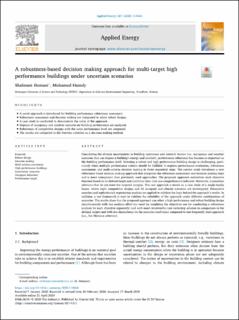| dc.contributor.author | Homaei, Shabnam | |
| dc.contributor.author | Hassan Mohamed, Mohamed Hamdy | |
| dc.date.accessioned | 2022-02-14T09:34:45Z | |
| dc.date.available | 2022-02-14T09:34:45Z | |
| dc.date.created | 2020-04-22T14:24:23Z | |
| dc.date.issued | 2020 | |
| dc.identifier.citation | Applied Energy. 2020, 267 . | en_US |
| dc.identifier.issn | 0306-2619 | |
| dc.identifier.uri | https://hdl.handle.net/11250/2978662 | |
| dc.description.abstract | Considering the diverse uncertainties in building operations and external factors (i.e., occupancy and weather scenarios that can impact a building’s energy and comfort), performance robustness has become as important as the building performance itself. Selecting a robust and high performance building design is challenging, particularly when multiple performance criteria should be fulfilled. It requires performance evaluation, robustness assessment, and multi-criteria decision making in three sequential steps. The current study introduces a new robustness-based decision making approach that integrates the robustness assessment and decision making steps and is more transparent than previously used approaches. The proposed approach normalizes each objective function based on its defined target and combines them into one comprehensive indicator. Moreover, it penalizes solutions that do not meet the targeted margins. The new approach is tested on a case study of a single-family house, where eight competitive designs and 16 occupant and climate scenarios are investigated. Exhaustive searches and sophisticated engineering analysis are applied to validate the logic behind the approach’s results. In addition, a test framework is used to validate the reliability of the approach under different combinations of scenarios. The results show that the proposed approach can select a high performance and robust building design simultaneously with less analysis effort (no need for weighting the objectives nor for conducting a robustness analysis for each objective separately) and with much trustworthy rate (selecting solution in comparison to the defined targets and with less dependency on the scenario conditions) compared to one frequently used approach (i.e., the Hurwicz criterion). | en_US |
| dc.language.iso | eng | en_US |
| dc.publisher | Elsevier | en_US |
| dc.rights | Navngivelse 4.0 Internasjonal | * |
| dc.rights.uri | http://creativecommons.org/licenses/by/4.0/deed.no | * |
| dc.title | A robustness-based decision making approach for multi-target high performance buildings under uncertain scenarios | en_US |
| dc.type | Peer reviewed | en_US |
| dc.type | Journal article | en_US |
| dc.description.version | publishedVersion | en_US |
| dc.source.pagenumber | 19 | en_US |
| dc.source.volume | 267 | en_US |
| dc.source.journal | Applied Energy | en_US |
| dc.identifier.doi | 10.1016/j.apenergy.2020.114868 | |
| dc.identifier.cristin | 1807529 | |
| dc.relation.project | Norges forskningsråd: 257660 | en_US |
| cristin.ispublished | true | |
| cristin.fulltext | original | |
| cristin.fulltext | original | |
| cristin.qualitycode | 1 | |

